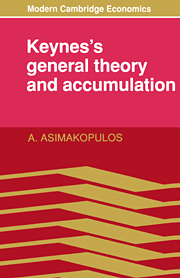Book contents
- Frontmatter
- Contents
- Series preface
- Preface
- 1 Introduction
- 2 Towards The General Theory
- 3 The General Theory of employment
- 4 Consumption and investment
- 5 Money, finance and the rate of interest
- 6 Equilibrium, change and time
- 7 Harrod and dynamic economics
- 8 Robinson on the accumulation of capital
- 9 Conclusion
- References
- Indexes
5 - Money, finance and the rate of interest
Published online by Cambridge University Press: 24 October 2009
- Frontmatter
- Contents
- Series preface
- Preface
- 1 Introduction
- 2 Towards The General Theory
- 3 The General Theory of employment
- 4 Consumption and investment
- 5 Money, finance and the rate of interest
- 6 Equilibrium, change and time
- 7 Harrod and dynamic economics
- 8 Robinson on the accumulation of capital
- 9 Conclusion
- References
- Indexes
Summary
INTRODUCTION
The General Theory is concerned with the operations of a monetary production economy, and the existence of money affects the analysis in an essential way. The technical details of money – details that had occupied considerable space in the Treatise on Money – art ignored, but the importance of money in the General Theory should not be underestimated. Its presence pervades the analysis, and it complements the historical setting of the particular short period considered by linking uncertain expectations about an unknown future to current employment. ‘A monetary economy … is essentially one in which changing views about the future are capable of influencing the quantity of employment and not merely its direction’ (Keynes 1936: vii). Money is held not only to facilitate transactions, but also as a store of value, as one of the assets in which wealth is held. It can serve this function, even though it earns little or no interest, because there are advantages to holding a part of wealth in money or near-monies when contracts are written in terms of money, as long as the purchasing power of money is expected to be relatively stable. The prices that will be obtained for bonds and physical assets, if they have to be sold at some future time, cannot be known because of the inescapable uncertainty over future conditions.
- Type
- Chapter
- Information
- Keynes's General Theory and Accumulation , pp. 85 - 119Publisher: Cambridge University PressPrint publication year: 1991



